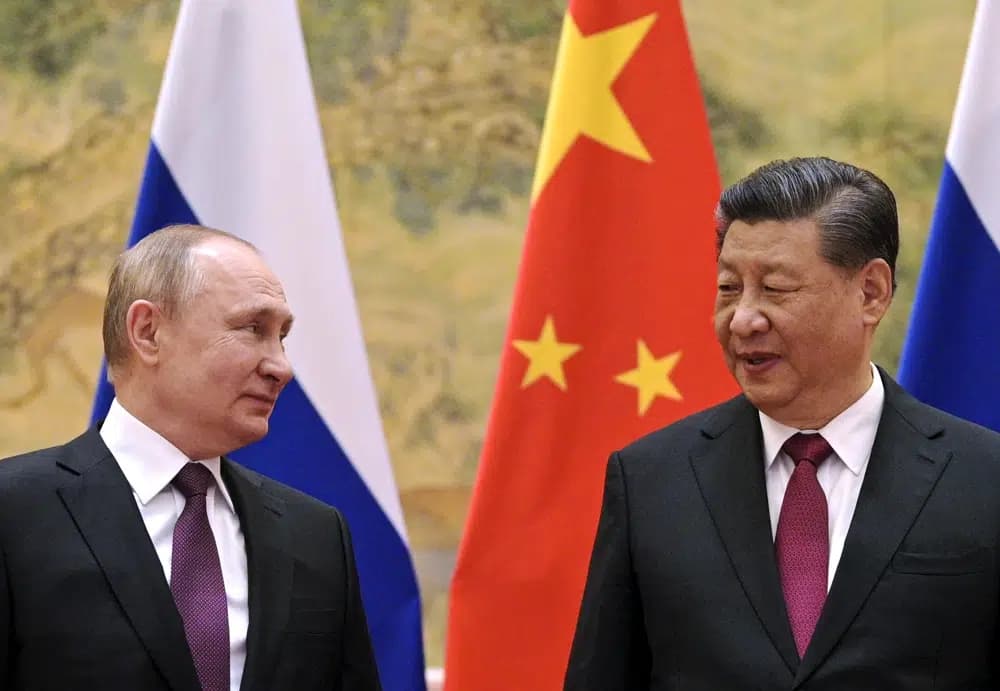ROME – As President Xi Jinping of China continues his “journey of friendship, cooperation and peace” to Moscow to cement ties with President Vladimir Putin, the outing is setting off alarms in Western capitals, where officials are worried, among other things, that Beijing’s heretofore tacit support for Russia’s war in Ukraine might turn overt.
More broadly, Western leaders seem to fear the leaders of the world’s two largest and most powerful authoritarian states are cementing an anti-democratic alliance. White House national security spokesman John Kirby groused that “these are two countries that have long chafed at U.S. leadership around the world,” while American Secretary of State Anthony Blinken warned that Xi’s visit just after Putin had been indicted by the International Criminal Court for war crimes will “provide diplomatic cover for Russia to continue to commit those very crimes.”
As Financial Times columnist Gideon Rachman put it, “Russia and China remain close partners — linked by their joint hostility to America and its allies.”
Yet there was one traditionally Western center of power that seemed immune to the anxiety: The Vatican under Pope Francis.
Coverage of the summit in the Vatican’s state-owned media has been neutral-to-positive. A subhead on the “Vatican News” site Monday described “great expectations” for a visit which, “beyond reinforcing reciprocal relations, has the stated purpose of promoting peace talks.” Coverage in L’Osservatore Romano, the Vatican newspaper, emphasized China’s 12-point peace plan for Ukraine, while also noting American reservations.
What gives?
Increasingly, the Vatican is a “Western” institution only in the limited sense that it’s physically located in western Europe. In terms of geopolitical orientation under history’s first pope from the developing world, however, the Vatican seems more and more like the capital of a global institution positioning itself to function in a multipolar era.
When NATO was founded in 1949, Pius XII was pope and he was dubbed the new alliance’s “chaplain” because of the Vatican’s overtly anti-Communist stance. From the beginning, Francis made clear he represented a break with that instinctive reliance on European and North American patronage; in September 2013, for instance, he called for a day of prayer and fasting for peace when it seemed the Western powers were poised to use military force to dislodge the regime of Bashar al-Assad in Syria.
In fact, Francis’s position on Syria substantively was closer to Putin than the White House or 10 Downing Street, an alignment that was ratified when Putin called on the new pope in November 2013 and the two leaders agreed on the need for a negotiated settlement.
In part, Francis’s multipolar outlook is the product of biography. Jorge Mario Bergoglio carried the same ambivalence about the United States into the papacy as many other Latin American prelates, given the checkered history of American involvement in the region.
In part, too, Vatican multipolarism is a confirmation of Auguste Comte’s famous dictum that “demography is destiny.” Francis leads a church of 1.3 billion people, two-thirds of whom today live outside the West, a share that will reach three-quarters by midcentury. Catholics in Africa, in Asia, in Latin America, and in the Middle East, all see the global chessboard differently than Westerners, a truth confirmed by attitudes towards the conflict in Ukraine.
Thus when Xi told Putin Monday that “China will work with Russia to uphold true multilateralism, promote a multipolar world and greater democracy in international relations, and help make global governance more just and equitable,” it was rhetoric destined to play well in Rome.
Rather than concern, there’s every reason to believe that Pope Francis sees Xi’s outing to Moscow positively, as an opportunity to promote the pope’s own desire for a negotiated end to the war, including a halt to the Western flow of arms into the region.
While Western leaders largely have dismissed China’s peace plan for Ukraine, styling it as little more than a reward for Russian aggression, the Vatican’s been quietly encouraging.
In part, Vatican hopes for a positive outcome to Xi’s mission may have been buoyed by China’s recent success in brokering a deal between Saudi Arabia and Iran to reestablish diplomatic relations between those two traditional rivals. Although the Vatican didn’t publicly comment on the breakthrough, sources close to Lebanon’s interim Prime Minister Najib Mikati say the deal was discussed positively during his meetings with Pope Francis and his top diplomatic aide, Italian Cardinal Pietro Parolin, last Thursday.
In other ways too, the Vatican has gone out of its way to show deference to China. Last week’s audience with a group of Buddhists from Taiwan and Japan, from which any mention of the Dalai Lama once again was conspicuously absent, was a reminder that Francis has closed the door to even the sort of private encounters that John Paul II and Benedict XVI were once willing to grant the premier thorn in Beijing’s side.
Francis also recently met Xiao Wunan, a Chinese entrepreneur with close ties to Xi, who presented him with a gift of digital art and told the pontiff, “We know clearly that under your guidance, relations between China and the Vatican have improved.”
Pope Francis’s top geopolitical desideratum today is a revival of the 1970s-era Helsinki process, seeing it as a precedent for a genuinely multilateral approach to global affairs. In that effort, Francis realizes that he can’t just rely on Western partners, but will require the support of other centers of power – perhaps, above all, China, as Xi looks to recast himself as a global statesman during his unprecedented third term as leader.
Bottom line: Officials in Washington, London, and Brussels may be waking up nervous today. Rome, however – that is, at least, ecclesiastical Rome – likely will be more at ease, seeing Xi’s exchanges with Putin not as the crucible for a new “axis of evil,” but rather as a downpayment on a more multipolar world.






